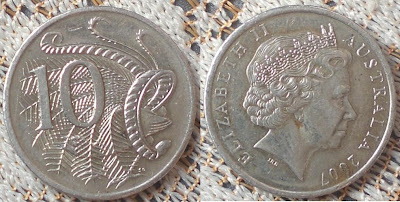 The reverse shows the spiny anteater, also known as an Echidna. The echidna has a small tail and a narrow beak. There are short-beaked echidnas and long-beaked echidnas. The mouth is toothless and very tiny. The body is heavy and round. Everywhere except the belly, it is covered with coarse hairs and short, pointy spines. (They're very different than the spines on a porcupine!) Each foot has five toes with strong claws. On each hind foot there is an extra long, curved claw on the second toe; the echidna uses this claw to clean between its spines.
The reverse shows the spiny anteater, also known as an Echidna. The echidna has a small tail and a narrow beak. There are short-beaked echidnas and long-beaked echidnas. The mouth is toothless and very tiny. The body is heavy and round. Everywhere except the belly, it is covered with coarse hairs and short, pointy spines. (They're very different than the spines on a porcupine!) Each foot has five toes with strong claws. On each hind foot there is an extra long, curved claw on the second toe; the echidna uses this claw to clean between its spines.The spiny anteater is an nocturnal animal. He becomes active at twilight and spends the rest of the night digging out ants and termites which he pulls in with his long, sticky tongue. His vision is weak, but he has a strong sense of smell and sharp hearing. The echidna can go without food for long periods of time. When threatened, the echidna can quickly roll into a prickly ball for protection.
 What may seem like a creative design on first glance, is actually the superb lyrebird of Australia, as shown on the reverse of this 10 cent coin.
What may seem like a creative design on first glance, is actually the superb lyrebird of Australia, as shown on the reverse of this 10 cent coin.The lyrebird is another anomalic ancient creature of Australia with few close relatives. We have the Albert's lyrebird and the superb lyrebird, which is shown on the coin above. Both are known for their song, and it is the superb lyrebird which is well known for its songs, which are composed primarily of variegated mimicry. It can mimic voices of other birds and other natural sounds including flight calls of parrots and wing beats of large birds.
The lyrebirds being flightless, face predation from non-native dogs and feral cats. There is a need to protect them and their habitat.

The 20 cent coin has the platypus on the reverse. The duck billed platypus is the only egg laying mammal, an anomaly that has somehow survived all these years in the isolated location of Australia, like many other unique creatures like emu, kangaroo, marsupial lion, moa etc that are or were found in Australia and New Zealand. The platypus is the oldest mammal which is not yet extinct, and can be called a living fossil. The obverse shows queen Elizabeth.








No comments:
Post a Comment